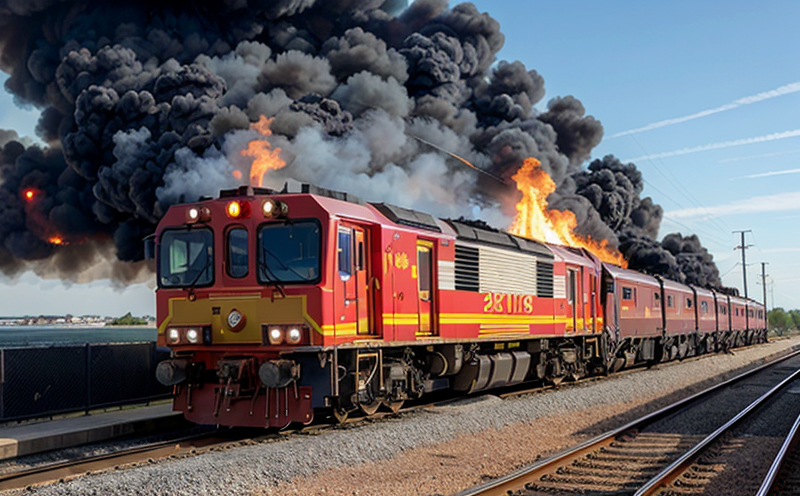Reaction-to-Fire Testing of Railway Door Panels
The Reaction-to-Fire (RFT) testing of railway door panels is a critical component in ensuring fire safety within railway vehicles. This test evaluates how effectively the materials used in railway door panels perform during exposure to fire. It assesses not only their resistance to ignition but also the rate at which they burn, the amount of heat and smoke released, and the duration before structural failure occurs.
The primary aim of this testing is to comply with stringent international standards such as EN 45545-2:2018, which mandates specific fire performance requirements for railway vehicles. This standard ensures that materials used in railway applications are not only safe but also contribute positively to the overall safety and evacuation process during a fire emergency.
During RFT testing of railway door panels, various parameters need to be carefully controlled and monitored. These include temperature, oxygen concentration, and the type of fuel used to simulate real-world conditions. Specimens undergo exposure to these conditions for specific durations while being observed by experienced technicians who record detailed data on their performance.
The test involves placing a specimen in a specially designed combustion chamber where it is subjected to controlled levels of heat and flame according to predefined protocols. The duration, intensity, and type of fuel used are all meticulously planned to simulate realistic fire scenarios. Once the exposure period ends, the panel's performance is analyzed based on several criteria including time to ignition, maximum flame spread rate, smoke production, and residual strength after fire exposure.
Understanding these parameters helps manufacturers optimize their designs by selecting appropriate materials that meet both regulatory requirements and operational needs. By conducting rigorous RFT tests early in the development process, engineers can identify potential issues before they become costly or safety-critical defects later on.
For quality managers responsible for ensuring product compliance, this test provides assurance that newly developed products will pass necessary certifications without further modification. Compliance officers play a crucial role by staying informed about changing regulations and trends within the industry so they can advise their organizations accordingly. R&D engineers benefit greatly from having access to reliable testing facilities since these tests offer valuable insights into material behavior under extreme conditions.
In conclusion, Reaction-to-Fire Testing of Railway Door Panels is essential for maintaining high standards of fire safety in public transportation systems worldwide. It serves as a vital tool in reducing risks associated with fires on trains and protecting passengers' lives and property during emergencies.
Why It Matters
The significance of Reaction-to-Fire Testing cannot be overstated in the context of railway safety. As urbanization continues to grow, so does the reliance on public transportation systems. Ensuring that these systems are safe and reliable is paramount not only for passenger confidence but also for regulatory compliance.
In the event of a fire aboard a train, quick action is crucial. The ability of railway door panels to withstand flames without spreading them further significantly reduces the risk of injury or death. Additionally, materials that produce less smoke contribute to better visibility and air quality within the vehicle, allowing passengers more time to evacuate safely.
From an operational perspective, compliance with international standards like EN 45545-2:2018 ensures that railway vehicles are up-to-date with current safety practices. This not only protects the public but also helps operators avoid costly downtime due to non-compliance issues.
In summary, Reaction-to-Fire Testing is essential for maintaining high standards of fire safety in public transportation systems worldwide. It serves as a vital tool in reducing risks associated with fires on trains and protecting both passengers' lives and property during emergencies.
Benefits
- Enhanced Safety: Ensures that materials used in railway door panels do not contribute to the spread of fire or increase smoke production, thereby enhancing overall safety for passengers.
- Regulatory Compliance: Meets stringent international standards such as EN 45545-2:2018, ensuring that products are up-to-date with current safety practices and avoiding costly downtime due to non-compliance issues.
- Improved Reputation: Demonstrates a commitment to quality and safety, which can enhance the reputation of manufacturers among customers and stakeholders.
- Cost Efficiency: Identifies potential problems early in the development process, reducing the need for costly modifications later on. It also minimizes risks associated with non-compliance penalties.
Incorporating Reaction-to-Fire Testing into your quality assurance program is a strategic investment that pays dividends through improved safety, regulatory compliance, enhanced reputation, and cost efficiency.
Why Choose This Test
Selecting the appropriate testing method for railway door panels is crucial given the stringent requirements set forth by international standards such as EN 45545-2:2018. Compliance with these regulations ensures that materials used in railway applications are not only safe but also contribute positively to the overall safety and evacuation process during a fire emergency.
The choice of test method depends on several factors including the type of material being tested, its intended application within the vehicle, and the specific criteria outlined by relevant standards. For example, some tests may focus solely on flame spread while others might evaluate smoke production or heat release.
Experience in performing these types of tests is also critical. Skilled technicians who understand both theoretical aspects and practical applications will ensure accurate results that reflect real-world performance accurately. This expertise allows for precise control over test parameters, ensuring consistent and reproducible outcomes.
In conclusion, choosing the right Reaction-to-Fire Test involves careful consideration of multiple factors including material type, intended application, and relevant standards. With experienced personnel overseeing each step of the process, you can be confident in achieving reliable results that meet all necessary requirements.





